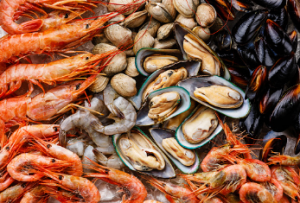Frozen seafood is an increasingly important revenue source for supermarkets. According to recent reports, the North American frozen seafood market is expected to reach $16.1 billion by 2026.
 Processes used to freeze seafood.
Processes used to freeze seafood.
Depending on the type of seafood, freezing can take several different forms. Blast freezing, for example, is a popular choice for preserving seafood. This process uses high-velocity cold air to freeze fish at a very low temperature. This process can leave a unique taste and texture and help preserve the freshness of the seafood. Many freezers are available; some have conveyor belts that move the frozen fish from one chamber to another.
Although most of the processes used for freezing fish do not alter the meat’s quality, there are differences in the nutritional value and sensory properties. For example, the functionality of proteins decreases when frozen, and the thaw-drip values drop. The deterioration is attributed to changes in the fish’s biochemical state, including fatigue and stress.
In experiments on snakehead fillets, scientists studied the effect of different freezing methods on the quality of the meat. When freezing snakeheads using liquid nitrogen, the fish developed more cracks and a reduced capacity for holding water. They also noted that the size of ice crystals varied between the central and surface portions of the snakehead, although these differences were not enough to impact the quality of the tuna meat significantly.
The process can also cause ice crystals in the flesh of the fish. It can cause water separation, which is detrimental to the meat. Another method that has been developed to improve the quality of frozen fish is using a 1M NaCl solution. When thawing the fish, it is important to avoid thawing the fish for more than a few hours because of the risk of thawing the meat.
Freezing can be a cost-effective method of preserving fish for long periods. Frozen fish can be hard to distinguish from fresh fish, even after three months. However, proper packaging is essential to ensure a healthy and safe product. In addition, freezing temperatures must be maintained between minus 2.2 degrees Celsius and 28 degrees Fahrenheit. This heat removal is necessary to achieve the frozen state of the seafood.
Nutritional value
The nutritional value of Shore Mariner frozen seafood has increased over the last several years, driven by a desire for more healthy, nutritious foods. However, the market faced several challenges during the first quarter of 2020. First, the COVID-19 pandemic triggered a recession, leaving many low-income consumers struggling financially.
This situation also created a need for packaged foods and home-cooking products that could be easily prepared. Secondly, the recession made consumers more health conscious and preferred foods with essential nutrients.
However, some people still believe that fresh seafood is healthier, which is not true. Frozen seafood has just as much nutritional value as fresh. The biggest difference is in the method of freezing. Modern freezing methods do not result in the loss of taste or texture. Instead, it retains the same nutrients and beneficial fats as fresh seafood.
Frozen fish retains all nutrients and is just as healthy as fresh fish. It has the same omega-3 fatty acids and lean protein as fresh fish. These benefits make frozen fish a viable alternative to fresh seafood. Therefore, it is essential to include fish in your diet regularly.
Frozen seafood has the highest nutritional value of fresh fish. It also retains its taste and texture after freezing. In addition, it is much easier to cook. The process also saves on food waste. Therefore, frozen seafood is an excellent option for people with limited time. The nutrients are retained without loss of taste and texture.
Environmental impact
The Environmental Impact of Frozen Seafood: A New Study Reveals the Environmental Impact of Frozen Seafood. The study takes a comprehensive look at the seafood industry and its impact on the climate. It considers the entire supply chain, from the oceans to the processing plants. The impacts of the seafood industry on the climate are largely linked to the fuel burned in transport. Frozen seafood may be less harmful to the environment than fresh seafood, but the carbon footprint can still be high.
Many consumers perceive Shore Mariner frozen seafood as being cheaper and of lower quality. They expect to pay less for fresher seafood, a big problem for small-scale commercial fishermen. They need to meet higher price margins to stay afloat. However, a movement is underway to change consumer perceptions of frozen seafood. One strategy is to promote recipes created by professional chefs. It may be more effective than trying to sell consumers the benefits of using frozen seafood.